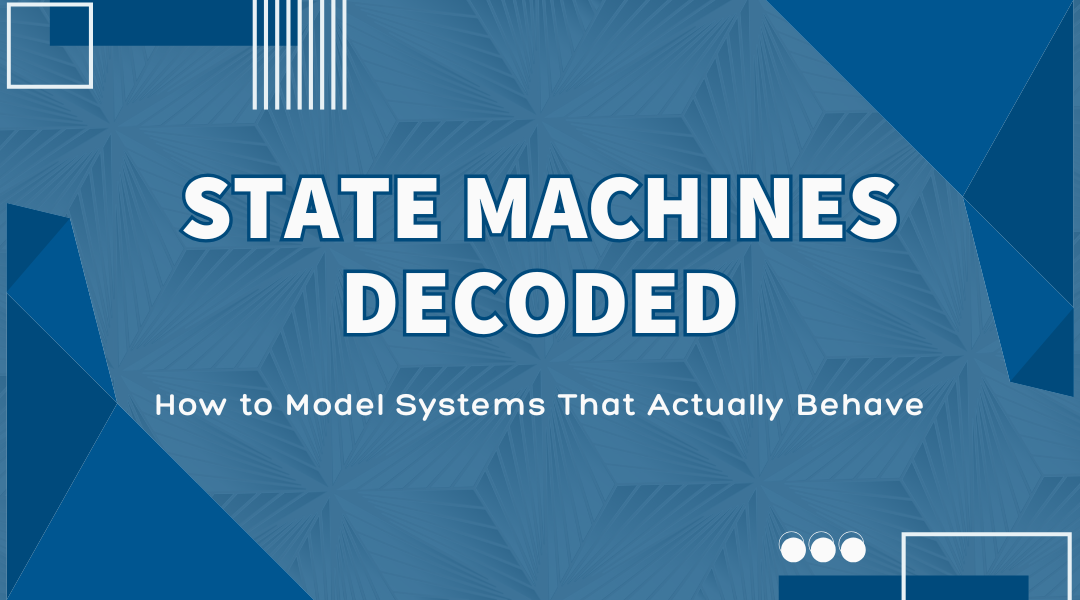You know that sinking feeling when you demo a system and it gets stuck in some weird state nobody anticipated? Maybe the elevator doors won’t open, or the payment system hangs on “processing” forever. I’ve been there – and that’s exactly why state machines became my secret weapon.
Let me show you how to model systems that don’t embarrass you in production, using examples from real systems I’ve rescued.
The Coffee Machine That Drove Everyone Crazy
A client’s “smart” office coffee maker had two annoying habits:
- It would sometimes start brewing with no cup present
- It would get stuck “heating” forever on Monday mornings
When we mapped its states and transitions, the problems became obvious:
What They Designed:
- [Idle] → (button press) → [Brewing] → (timer) → [Done]
What Was Actually Happening:
- [Idle] → (ghost button press from power surge) → [Brewing]
- [Heating] → (voltage drop from microwave use) → [Stuck]
State Machines in Plain English
Think of states as distinct moods your system can be in:
- Solid States (like concrete conditions)
- “Door locked”
- “Payment approved”
- “Battery critical”
- Squishy States (that cause trouble)
- “Processing…” (how long?)
- “Ready soon” (what does that mean?)
- “Almost done” (kill me now)
Transitions are the triggers that change these states:
- Good: “When temperature reaches 200°F, move from Heating to Brewing”
- Bad: “When things seem right, proceed” (this always ends in tears)
Building a Bulletproof State Machine
Step 1: Find All the States (Even the Ugly Ones)
For a conference room booking system:
- Available
- Reserved
- In-use
- Maintenance
- Secret State: “Reserved but no-show after 15 minutes” (this is where systems break)
Step 2: Map the Legal Moves
Draw arrows showing allowed transitions:
- Available → Reserved (by booking)
- Reserved → In-use (by check-in)
- Reserved → Available (after no-show timeout)
Step 3: Plug the Holes
Add guard conditions like:
- Can’t go from Maintenance → In-use without inspection
- Can’t override existing booking unless admin
Real-World War Stories
The Elevator That Wouldn’t Quit
A high-rise elevator kept reporting “Door stuck” errors. The state machine revealed:
- Normal flow: Open → Wait → Close
- Reality: Open → (obstruction) → Partially open → (sensor conflict) → ERROR
Fix: Added explicit “Obstructed” state with clear recovery path
The Parking Gate That Loved Chaos
A parking system kept letting cars in without payment. Why?
- It had states for “Read tag” and “Raise gate”
- But no state for “Tag read but payment failed”
Fix: Added explicit failure states with different behaviors
Pro Tips From the Trenches
- Name States Like You’re Yelling at a Junior Dev
- Bad: “Processing”
- Good: “Awaiting bank authorization”
- Better: “Payment pending – do not refresh!”
- Timeouts Save Lives
Every waiting state needs:- Max duration
- Failure path
- Recovery action
- Model the Stupid User
Add transitions for:- Multiple rapid clicks
- Walking away mid-process
- Trying to cheat the system
- Visualize Like a Crime Board
Use:- Red for error states
- Yellow for temporary states
- Green for happy path
When State Machines Aren’t the Answer
- For simple on/off systems (just use a boolean)
- When modeling data flow (try activity diagrams)
- For showing physical layouts (component diagrams work better)
The Consultant’s Cheat Sheet
Always Model:
- Startup/shutdown sequences
- Failure modes
- Maintenance states
- User interruption paths
Always Avoid:
- “Miscellaneous” states
- Transitions without clear triggers
- States that can’t be observed/tested
Remember: The difference between a professional system and an amateur one often comes down to how well it handles all those weird edge cases. And state machines are how you anticipate those cases before they happen in production.
Next time you’re designing a system, ask: “What are all the possible conditions this thing can get into?” Then model those states explicitly. Your future self (and your users) will thank you.
